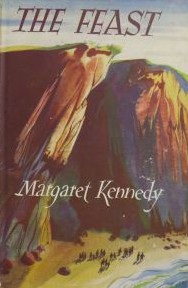Inspiring Older Readers
 posted on 21 Aug 2017
posted on 21 Aug 2017
The Feast by Margaret Kennedy
I can’t imagine I would ever have stumbled across this book had it not been for a slightly mysterious email thanking me for my positive article published on this site about Arthur Calder Marshall and his extraordinary book The Fair To Middling. The email came from Alison Lurie ( and I still don’t know if that’s THE Alison Lurie or not) asking whether I knew of any more titles that come from that sort of unexpected left-field. I didn’t but in that same email she mentioned her fondness for Margaret Kennedy’s The Feast which she clearly considered fitted that slightly eccentric mould.
I was intrigued enough to order a copy and I have to say that it is a pretty extraordinary read. Margaret Kennedy is perhaps best known for her 1924 novel of sexual jealousy and love in the middle classes, The Constant Nymph, which at the time caused something of a minor sensation. I’ve personally never felt moved to read it – it’s the sort of novel title that does to me what Kryptonite does to Superman.
The Feast, however, was written much later and published in 1950 when Kennedy was 54. The genesis of the novel is reputed to lie in a meeting of literary friends that took place just prior to the Second World War when Kennedy was captivated by the idea of a book based around the Medieval Masque of the Seven Deadly Sins. That proposal came to nothing but it did form the basis of a story that would gather the Sins all under the roof of a Cornish seaside hotel managed by the unhappy wife of Sloth (Faber & Faber).
The novel starts by introducing us to the cast of adults and children who will all gather together for a week at a Cornish seaside hotel perched on the very edge of a cliff overlooking the beach. Representatives of all the seven deadly sins are artfully drawn and play out dramas between themselves as families and between each other as new relationships and bonds are forged. None of the adults here are morally or ethically spotless and some of them are plain hateful. Children are the only ones here with a claim to any element of innocence but even they show the symptoms of adult corruption.
The cast of characters is well captured by the Fleur In Her World website:
There’s not much plot, but the story is driven very well by the disparate band of characters: visitors, hoteliers, and locals.
Mr and Mrs Siddal are the proprietors, and she’s nearly worn out trying to keep things going, because her husband is bone idle. She couldn’t manage without her boys, but they’re grown now, and ready to strike out on their own once the season is over. They do have a housekeeper, an impoverished gentlewoman, but Miss Ellis is a terrible snob, a vicious gossip and very selective about what she will and will not do. But they also have Nanciblel, who comes in daily from the village, and is a lovely girl, a real treasure.
Lady Gifford had sent details before she arrived with her husband and her four children in tow. She was in poor health, the kind of poor health that required comfort, fine food, attention, and having everything her own way. Mrs Cove had no time for such things. She had lived through the blitz, she had kept her three children by her side, and now she was going to give them a good holiday. She presented herself as a paragon, but she was quite the opposite, and before the week was over she would reveal her true colours.
And then there was a quiet couple who had survived a terrible tragedy; a militant clergyman and his downtrodden daughter; and a hack novelist, accompanied by her very sociable secretary.
As the morality tale gets into full swing, adults are forced to make choices and respond to new circumstances – those that do have some hope of salvation but those that don’t can expect to face the consequences.
A clever device at the beginning of the book gives us some important information – we know that the hotel will suffer a cataclysmic tragedy and crash down on to the beach below when the cliff collapses killing several people but we don’t know who that will be. To complicate things still further we discover that in order to placate and comfort the children a feast has been planned which will take place on the beach that same day.
We don’t discover who is killed and who is saved until the very last pages of the book and we don’t see the ramifications of the event – ultimately punishment is final and, we feel, just.
But what makes this book so remarkable is the way Kennedy plays with style and structure. Time shifts around, there are occasional excursions into stream of consciousness, there are aspects of traditional romance, suggestions of decadence and paedophilia – it’s as if the whole book is a heady brew of influences that the author has absorbed and then turned to her own uses.
A truly odd and unsettling book but not one which is especially easy to read because of the experimentation and rule-breaking. You’ll need to be patient and take your time with it because the whole picture forms slowly, rather like doing a complex jigsaw. But you will find the final picture makes it worth your while.
Terry Potter
August 2017